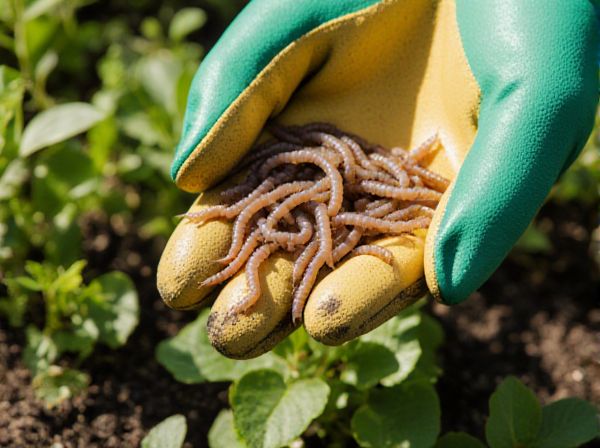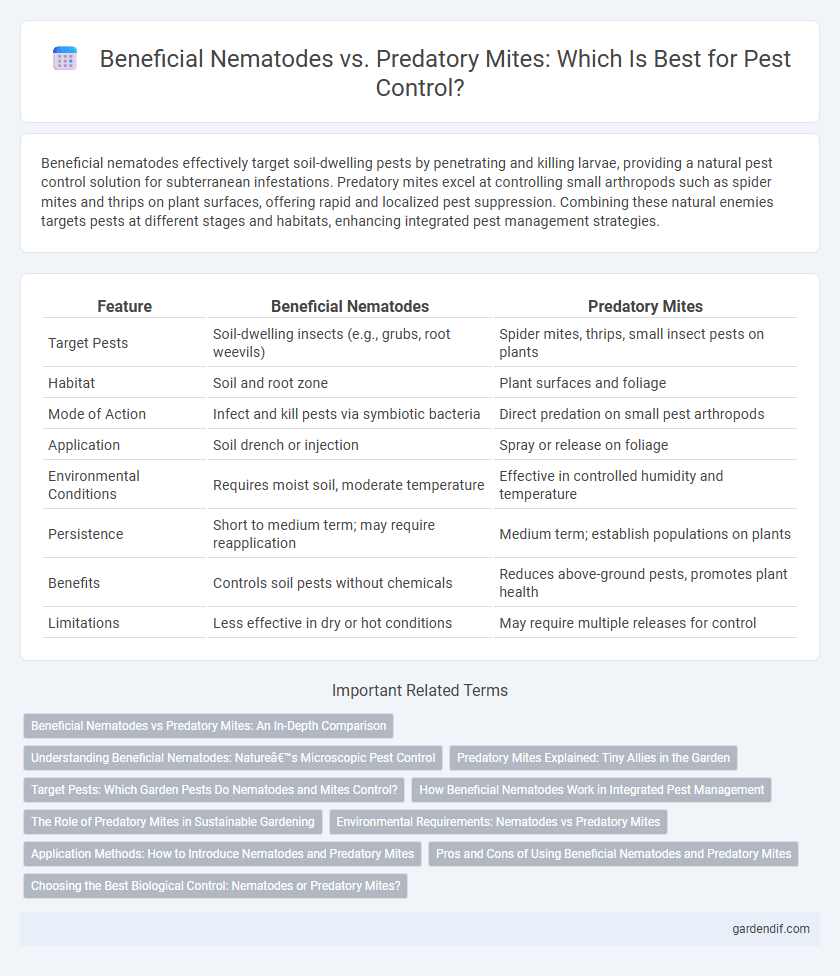
beneficial nematodes vs predatory mites Illustration
Beneficial nematodes effectively target soil-dwelling pests by penetrating and killing larvae, providing a natural pest control solution for subterranean infestations. Predatory mites excel at controlling small arthropods such as spider mites and thrips on plant surfaces, offering rapid and localized pest suppression. Combining these natural enemies targets pests at different stages and habitats, enhancing integrated pest management strategies.
Table of Comparison
| Feature | Beneficial Nematodes | Predatory Mites |
|---|---|---|
| Target Pests | Soil-dwelling insects (e.g., grubs, root weevils) | Spider mites, thrips, small insect pests on plants |
| Habitat | Soil and root zone | Plant surfaces and foliage |
| Mode of Action | Infect and kill pests via symbiotic bacteria | Direct predation on small pest arthropods |
| Application | Soil drench or injection | Spray or release on foliage |
| Environmental Conditions | Requires moist soil, moderate temperature | Effective in controlled humidity and temperature |
| Persistence | Short to medium term; may require reapplication | Medium term; establish populations on plants |
| Benefits | Controls soil pests without chemicals | Reduces above-ground pests, promotes plant health |
| Limitations | Less effective in dry or hot conditions | May require multiple releases for control |
Beneficial Nematodes vs Predatory Mites: An In-Depth Comparison
Beneficial nematodes are microscopic roundworms that target soil-dwelling insect larvae, providing effective control of pests like grubs and root weevils through parasitism. Predatory mites, by contrast, are arachnids that prey on small arthropod pests such as spider mites and thrips, offering surface-level pest management in foliage. Both organisms serve distinct ecological roles in integrated pest management, with nematodes excelling underground and predatory mites functioning primarily on plant surfaces.
Understanding Beneficial Nematodes: Nature’s Microscopic Pest Control
Beneficial nematodes are microscopic roundworms that target soil-dwelling pests by entering their bodies and releasing bacteria, effectively killing them within 48 hours. Predatory mites, on the other hand, specialize in controlling small insects and mite populations on plant surfaces by feeding on eggs and larvae. Understanding the unique hunting mechanisms and habitats of beneficial nematodes and predatory mites allows for targeted pest management strategies that enhance crop protection and reduce chemical pesticide use.
Predatory Mites Explained: Tiny Allies in the Garden
Predatory mites are microscopic arachnids that actively hunt pest insects such as spider mites, thrips, and whiteflies, providing natural pest control in gardens and greenhouses. Beneficial nematodes, on the other hand, are microscopic soil-dwelling worms that target soil-borne pests like grubs and root weevils by entering their bodies and releasing bacteria that kill them. While both serve as biological control agents, predatory mites excel in controlling foliage pests, making them indispensable allies for maintaining healthy plants above ground.
Target Pests: Which Garden Pests Do Nematodes and Mites Control?
Beneficial nematodes effectively target soil-dwelling pests such as root weevils, grubs, and fungus gnats by penetrating and killing larvae underground. Predatory mites control above-ground pests including spider mites, thrips, and small insect eggs by feeding on their soft bodies and disrupting reproduction cycles. Both biological controls offer complementary pest management strategies by addressing different pest habitats and life stages in the garden ecosystem.
How Beneficial Nematodes Work in Integrated Pest Management
Beneficial nematodes control soil-dwelling pests by actively seeking out and infecting larvae with symbiotic bacteria that kill the host within days, making them essential in Integrated Pest Management (IPM) for targeting root weevils, grubs, and fungus gnats. These microscopic organisms penetrate pest bodies through natural openings, releasing bacteria that induce rapid mortality without harming plants or beneficial insects, ensuring ecosystem balance. Their application in IPM reduces reliance on chemical pesticides, enhances sustainable pest control, and complements predatory mites, which primarily target above-ground pests like spider mites and thrips.
The Role of Predatory Mites in Sustainable Gardening
Predatory mites play a crucial role in sustainable gardening by naturally controlling pest populations such as spider mites, thrips, and whiteflies, reducing the need for chemical pesticides. Their effectiveness in maintaining ecological balance enhances plant health and promotes biodiversity within garden ecosystems. Utilizing predatory mites as a biological control method supports organic gardening practices and long-term pest management strategies.
Environmental Requirements: Nematodes vs Predatory Mites
Beneficial nematodes require moist soil environments with temperatures typically ranging from 50degF to 85degF to survive and effectively control soil-dwelling pests, thriving in shaded, organic-rich areas. Predatory mites prefer stable humidity levels around 60-80% and temperatures between 70degF and 90degF, often residing on plant surfaces or in protected microhabitats where they prey on small arthropods. Both pest control agents exhibit sensitivity to extreme environmental conditions, making habitat compatibility a crucial factor for maximizing their efficacy in integrated pest management systems.
Application Methods: How to Introduce Nematodes and Predatory Mites
Beneficial nematodes are typically applied through soil drenching or irrigation systems, ensuring they penetrate the root zone to target soil-dwelling pests effectively. Predatory mites are released directly onto infested plant surfaces, often using calibrated dispersal devices or manually applying them to foliage for precision targeting of spider mites and other pests. Both methods require maintaining optimal environmental conditions such as humidity and temperature for successful establishment and pest control efficacy.
Pros and Cons of Using Beneficial Nematodes and Predatory Mites
Beneficial nematodes effectively target soil-dwelling insect larvae and grubs by parasitizing them, offering a natural pest control method with minimal environmental impact. Predatory mites excel in controlling small pest populations like spider mites and thrips on plant surfaces but require specific conditions for optimal survival and reproduction. While nematodes provide deep soil pest control, their effectiveness can be reduced by desiccation and UV exposure, whereas predatory mites offer rapid pest suppression yet may need repeated applications and careful monitoring.
Choosing the Best Biological Control: Nematodes or Predatory Mites?
Beneficial nematodes excel in controlling soil-dwelling pests such as grubs, root weevils, and fungus gnats by penetrating the pest's body and releasing bacteria that kill them. Predatory mites target above-ground pests like spider mites, thrips, and whiteflies by actively hunting and feeding on them, providing effective control in greenhouse and field crops. Selecting the best biological control depends on the pest species, habitat (soil vs. foliage), and crop type, with nematodes preferred for soil pests and predatory mites ideal for managing foliar pest populations.
beneficial nematodes vs predatory mites Infographic

 gardendif.com
gardendif.com